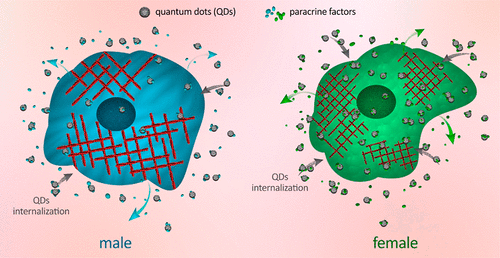|
NOVIDADES
 Responses to nanoparticles depend on cell sex. Credits: ACS NANO
A bias towards greater quantum dot uptake was found in hAMSCs taken from the amniotic sac of female foetuses compared with those from males. hAMSCs are some of the earliest sources of stemcells. The researchers also found gender-based differences in quantum dot uptake by somatic primary fibroblast cells from male and female adults, although here uptake was greater for male fibroblast cells. The researchers also investigated gender-based differences in the uptake of the nanoscale Sendai virus, which researchers use to transfect cells like hAMSCs into "induced pluripotent stem cells" (ipSCs). There is a lot of interest in ipSCs because they can differentiate into any other type of cell, a useful trait for medical treatments to replace damaged or diseased cells. Despite differences in the uptake mechanism, Kinsella and colleagues found a significant increase in Sendai virus uptake of hAMSCs and resulting ipSCs in hAMSCs from females compared with those from male hosts. "We suggest that cell sex is an overlooked factor in research relevant to the nanobio interface," they conclude in their report. They add, "Our continuous reports of the overlooked factors and future progress in the field of nanobio interfaces might have the potential to facilitate successful clinical translation of nanoparticles." Full details are reported in ACS Nano, DOI:10.1021/acsnano.7b06212. By Anna Demming. Nanotechweb.org. Posted: Mar 17, 2018. |
|||||||||||||||||||||||||